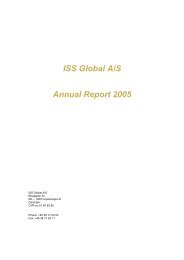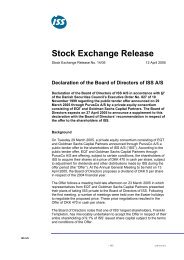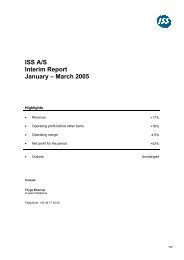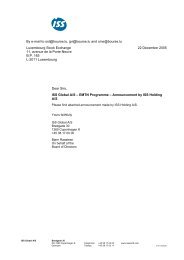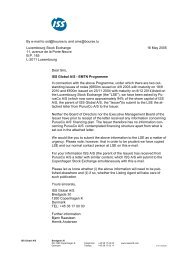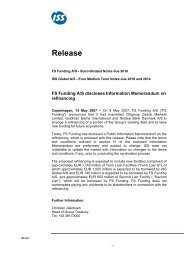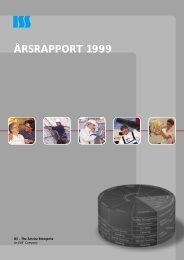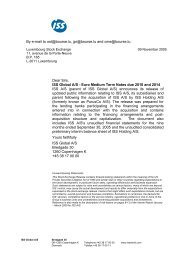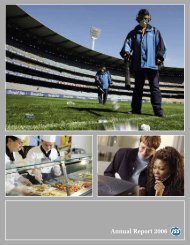Annual Report 2006 ISS Global A/S
Annual Report 2006 ISS Global A/S
Annual Report 2006 ISS Global A/S
You also want an ePaper? Increase the reach of your titles
YUMPU automatically turns print PDFs into web optimized ePapers that Google loves.
Organic growth<br />
<strong>ISS</strong> <strong>Global</strong> uses estimates of its organic growth in analysing its revenue, including in the analysis on page 32. Organic growth<br />
is intended to represent the percentage change in <strong>ISS</strong> <strong>Global</strong>’s revenue as compared to the prior period, excluding changes<br />
in revenue attributable to businesses acquired or divested and the effect of changes in foreign exchange rates. Organic<br />
growth is not a measure of financial performance under Danish GAAP or IFRS and should not be considered as a substitute<br />
for operating profit, net profit, cash flow or other financial measures computed in accordance with Danish GAAP or IFRS or<br />
as a measure of <strong>ISS</strong> <strong>Global</strong>’s results of operations.<br />
In calculating organic growth, <strong>ISS</strong> <strong>Global</strong> applies two different methodologies with respect to the revenue generated by acquired<br />
businesses, based upon the size of the acquisitions.<br />
Acquisitions of businesses with reported annual revenue of less than DKK 50 million (EUR 7 million)<br />
Acquisitions of businesses with reported annual revenue of less than DKK 50 million (EUR 7 million) and which do not establish<br />
an <strong>ISS</strong> <strong>Global</strong> presence in a new jurisdiction are treated as having been integrated into <strong>ISS</strong> <strong>Global</strong> upon acquisition and<br />
<strong>ISS</strong> <strong>Global</strong>’s calculation of organic growth includes changes in revenue of these acquired businesses from the date of acquisition.<br />
Accordingly, for such acquisitions, <strong>ISS</strong> <strong>Global</strong> calculates organic growth by including revenue generated by these acquired<br />
businesses in the current period, beginning with the date of acquisition. To establish a comparable base, revenue of<br />
the acquired businesses for the comparable prior period is added to <strong>ISS</strong> <strong>Global</strong>’s actual prior period consolidated revenue.<br />
The prior period revenue is generally based on internal management accounts of the acquired businesses and is subject to<br />
adjustments, on a case by case basis, to take into account additional information, available at the time of acquisition, regarding<br />
known material positive or negative changes in the acquired businesses, such as contract gains and losses. Such information<br />
may come from interim reports, management accounts of the acquired businesses or other sources. The difference<br />
between <strong>ISS</strong> <strong>Global</strong>’s actual current period consolidated revenue and its adjusted prior period consolidated revenue is<br />
deemed by <strong>ISS</strong> <strong>Global</strong> to be its organic growth, which is expressed as a percentage calculated by dividing organic growth<br />
calculated in this manner by <strong>ISS</strong> <strong>Global</strong>’s actual prior period consolidated revenue. The calculations of organic growth are<br />
based on the unaudited internal management accounts of the acquired businesses and related estimates. These organic<br />
growth numbers have not been, and cannot be, audited.<br />
Acquisitions of businesses with reported annual revenue of DKK 50 million (EUR 7 million) or more<br />
Prior to 1 January 2005, <strong>ISS</strong> <strong>Global</strong> used the methodology it applies to acquisitions of businesses with reported annual revenue<br />
of less than DKK 50 million (EUR 7 million) to acquisitions of businesses with reported annual revenue of DKK 50 million<br />
(EUR 7 million) or more, as well as to acquisitions that establish an <strong>ISS</strong> <strong>Global</strong> presence in a new jurisdiction. Since that<br />
date, <strong>ISS</strong> <strong>Global</strong> has treated these acquisitions differently. Under the new approach, <strong>ISS</strong> <strong>Global</strong> excludes from its calculation<br />
of organic growth any growth generated by such larger acquisitions during the first 12 months of <strong>ISS</strong> <strong>Global</strong> ownership. The<br />
determination of current period revenue is straightforward for acquisitions that have not been integrated into <strong>ISS</strong> <strong>Global</strong>’s operations,<br />
and the revenue from these separate entities is disregarded in calculating organic growth. The determination of current<br />
period revenue is more complex for acquired businesses that have been integrated into <strong>ISS</strong> <strong>Global</strong>. In relation to integrated<br />
businesses <strong>ISS</strong> <strong>Global</strong> estimates current period revenue based on internal management reports, and exercises discretion<br />
in allocating revenue between the integrated and pre-existing operations, which may significantly affect the organic<br />
growth calculation. These organic growth numbers have not been, and cannot be, audited.<br />
<strong>ISS</strong> <strong>Global</strong> calculates organic growth by excluding revenue generated by divested businesses from its current period revenue.<br />
Such revenue is derived from <strong>ISS</strong> <strong>Global</strong>’s unaudited internal management accounts.<br />
Cost of sales<br />
Cost of sales consists primarily of costs of cleaning<br />
supplies, catering supplies and other materials used<br />
in <strong>ISS</strong> <strong>Global</strong>’s operations related to the recorded<br />
revenue. Cost of sales increased by DKK 1,158 million,<br />
or 31%, from DKK 3,753 million in 2005 to DKK<br />
4,911 million in <strong>2006</strong>. This increase was due primarily<br />
to acquisitions and organic growth. Cost of sales<br />
as a percentage of revenue increased from 8.1% in<br />
2005 to 8.8% in <strong>2006</strong> due to increased revenue<br />
from services with higher average cost of sales,<br />
primarily within Office Support services.<br />
Other operating expenses<br />
Other operating expenses consists primarily of selling<br />
and distribution costs, subcontracting costs, administrative<br />
expenses, marketing and advertising<br />
expenses and vehicle lease payments. Other operating<br />
expenses also include costs incurred in re-<br />
ANNUAL REPORT <strong>2006</strong> / Financial Review<br />
spect of professional services, such as audit and legal<br />
fees, as well as losses on accounts receivable.<br />
Other operating expenses increased by DKK 1,886<br />
million, or 22%, from DKK 8,671 million in 2005 to<br />
DKK 10,557 million in <strong>2006</strong>. This increase was due<br />
primarily to acquisitions and organic growth. Other<br />
operating expenses as a percentage of revenue increased<br />
slightly from 18.7% in 2005 to 18.9% in<br />
<strong>2006</strong><br />
Depreciation and amortisation<br />
Depreciation and amortisation consists of depreciation<br />
of property, plant and equipment and amortisation<br />
of intangible assets other than goodwill, customer<br />
contracts and brands. Depreciation and amortisation<br />
increased DKK 93 million, or 14.4%, from<br />
DKK 647 million in 2005 to DKK 740 million in <strong>2006</strong>.<br />
Depreciation and amortisation excluding amortisation<br />
of intangibles related to acquisitions remained<br />
33



